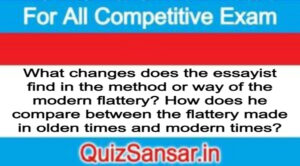
What changes does the essayist find in the method or way of the modern flattery? How does he compare between the flattery made in olden times and modern times?
What changes does the essayist find in the method or way of the modern flattery? How does he compare between the flattery made in olden times and modern times?
Ans.
The essayist has closely analyzed the modern methods of flattery and finds that the meaning and purpose of flattery has entirely been changed. In modern time the flattery or praising is made through the books, newspapers and magazines. The wealthy and great persons are praised through these modem mediums. The things related to the lives of wealthy and great men are picked up to praise. The writers and journalists collect information of their routine life. The hobbies, liking, disliking and living style of the wealthy and the great men are made the subject of praise. In olden times the flattery was straightforward and it was often made before some great person. The flatterer spoke at the face of the person whatever he liked to say in praise of the person. The flattery made in olden times was somewhat improbable. For example, when the courtiers sang in the praise of a King, they attributed him things that were entirely improbable. They compared his glory and personality with the Sun at noonday. They told him that he (the King) had the dazzling and glistening personality. They praised him by depicting his terror and fear among the people. They told the King that his people were completely submissive before him and they could not breathe without him. They made the King feel that he is the most powerful King of the world and he alone was able to conquer the whole world. They told him that nobody could stay before the glow of his sword. The essayist observes that in this method of flattery there was an absolute artificiality. In olden times the flatterer made the great person some supernatural personality. The King also liked such flattery and he was puffed up to hear such flattery.
In this way, the flatterer not only secured his place in the Court, but also succeeded in winning the heart of the King. Through this way of flattery the courtier showed great dedication for the King. In olden times the Kings were surrounded with a group of flatterers. These flatterers never allowed the King to know his real identity. They were also the greatest obstacles in the way of King’s glory and his duty for his people. They bandaged his eyes with their attractive words of flattery. Sometimes they brought the downfall of the King. The King never got opportunity to flourish. The King was so much puffed up with pride that he considered him an embodiment of supernatural powers. In this the King could not develop his public image nor he could make his relations with his people. He accepted whatever his flatterers poured into his ears.
The essayist thinks that in fact this kind of flattery was not only harmful for the King’s image but also gave rise to many disputes and hindrances. The essayist calls this method of flattery an upright method. In modern times, there is no straightforwardness in the method of flattery. Now-a-days the flattery made through books, newspapers and magazines seems to be real because the facts are mingled with fiction in a very clever manner.
The essayist observes that the writers and the journalists followed the same subjects and things of flattery. They do not bring any variation in their chosen subjects. But in olden times there was great adornment of subject and words. Hence, it is seen that the modern method of flattery or praise cannot create a freshness. The journalists remain failure to serve something new and freshing in the name of flattery, so at one time the readers feel extremely bored.
-
Write the critical appreciation of the poem No. 12 entitled Far Below Flowed.
-
Write the critical appreciation of the poem No. 11 entitled Leave this Chanting.






